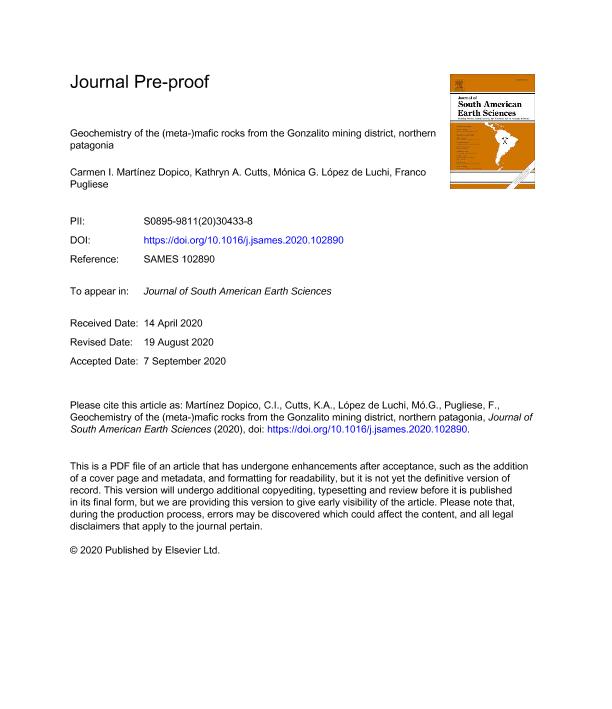Mostrar el registro sencillo del ítem
dc.contributor.author
Martínez Dopico, Carmen Irene

dc.contributor.author
Cutts, Kathryn Ann

dc.contributor.author
Lopez, Monica Graciela

dc.contributor.author
Pugliese, Franco Eduardo

dc.date.available
2021-10-20T17:55:19Z
dc.date.issued
2020-12
dc.identifier.citation
Martínez Dopico, Carmen Irene; Cutts, Kathryn Ann; Lopez, Monica Graciela; Pugliese, Franco Eduardo; Geochemistry of the (meta-)mafic rocks from the Gonzalito mining district, northern Patagonia; Pergamon-Elsevier Science Ltd; Journal of South American Earth Sciences; 104; 12-2020; 1-49
dc.identifier.issn
0895-9811
dc.identifier.uri
http://hdl.handle.net/11336/144528
dc.description.abstract
In spite of hosting one of the most important Pb–Ag–Zn mineralizations in Patagonia, the metamorphic history of the rocks of the Mina Gonzalito Complex (MGC; east of the North Patagonian Massif) is still unclear. The complex consists of schists, para- and ortho-derived gneisses, ranging from greenschist to amphibolite facies, and metamafic rocks. Leucogranites and pegmatites were intruded synkinematically. Field, petrological and thermochronological evidence indicates that the MGC experienced an early prograde path and metamorphic peak during the Early Ordovician (ca. 472 Ma), magmatism and localized post-peak deformation and re-equilibrium at lower pressure, followed by uplift during the Late Permian. The MGC is intruded by the calc-alkaline Santa Rosa Diorite (SiO2 = 58.7–60.4 wt%; LaN/YbN = 7.2–10.5) and trachyte dike swarms in the Late Permian- Early Triassic. The mafic intrusives of the MGC form small schistose, massive and banded bodies interlayered within the gneisses and granites and recorded recrystallization of hornblende + plagioclase + quartz + titanite ± clinopyroxene ± biotite ± ilmenite. The metamafic rocks are mostly tholeiitic gabbros having SiO2 (45.4–52.1 wt%), TiO2 (0.62–2.88 wt%), flat REE patterns (LaN/YbN = 0.48–2.76), although some pyroxene-banded varieties show higher ratios. Initial P–T modelling in the NCKFMASHTO system for the metamafic rocks defined P-T conditions between 550 and 730 °C and 1–4 kbar. Our data suggest that the protolith of the metamafic rocks was emplaced in a shallow environment, associated with underplating of mantle-derived magmas slightly modified by crustal contamination. The intrusion of mantle-derived magmas may have been related either to a magmatic arc or to a continental rift environment. The model involving an Ordovician intracontinental back-arc basin is favored herein because it can reasonably explain many other geological features of Early Paleozoic basement rocks from northern Patagonia.
dc.format
application/pdf
dc.language.iso
eng
dc.publisher
Pergamon-Elsevier Science Ltd

dc.rights
info:eu-repo/semantics/openAccess
dc.rights.uri
https://creativecommons.org/licenses/by-nc-sa/2.5/ar/
dc.subject
GABBROS
dc.subject
GONDWANA
dc.subject
NORTH PATAGONIAN MASSIF
dc.subject
ORDOVICIAN
dc.subject.classification
Mineralogía

dc.subject.classification
Ciencias de la Tierra y relacionadas con el Medio Ambiente

dc.subject.classification
CIENCIAS NATURALES Y EXACTAS

dc.title
Geochemistry of the (meta-)mafic rocks from the Gonzalito mining district, northern Patagonia
dc.type
info:eu-repo/semantics/article
dc.type
info:ar-repo/semantics/artículo
dc.type
info:eu-repo/semantics/publishedVersion
dc.date.updated
2021-09-07T18:38:13Z
dc.journal.volume
104
dc.journal.pagination
1-49
dc.journal.pais
Estados Unidos

dc.description.fil
Fil: Martínez Dopico, Carmen Irene. Consejo Nacional de Investigaciones Científicas y Técnicas. Oficina de Coordinación Administrativa Ciudad Universitaria. Instituto de Geocronología y Geología Isotópica. Universidad de Buenos Aires. Facultad de Ciencias Exactas y Naturales. Instituto de Geocronología y Geología Isotópica; Argentina
dc.description.fil
Fil: Cutts, Kathryn Ann. Universidade Federal de Ouro Preto; Brasil
dc.description.fil
Fil: Lopez, Monica Graciela. Consejo Nacional de Investigaciones Científicas y Técnicas. Oficina de Coordinación Administrativa Ciudad Universitaria. Instituto de Geocronología y Geología Isotópica. Universidad de Buenos Aires. Facultad de Ciencias Exactas y Naturales. Instituto de Geocronología y Geología Isotópica; Argentina
dc.description.fil
Fil: Pugliese, Franco Eduardo. Consejo Nacional de Investigaciones Científicas y Técnicas. Centro Científico Tecnológico Conicet - Córdoba. Centro de Investigaciones en Ciencias de la Tierra. Universidad Nacional de Córdoba. Facultad de Ciencias Exactas Físicas y Naturales. Centro de Investigaciones en Ciencias de la Tierra; Argentina
dc.journal.title
Journal of South American Earth Sciences

dc.relation.alternativeid
info:eu-repo/semantics/altIdentifier/url/https://linkinghub.elsevier.com/retrieve/pii/S0895981120304338
dc.relation.alternativeid
info:eu-repo/semantics/altIdentifier/doi/http://dx.doi.org/10.1016/j.jsames.2020.102890
Archivos asociados
